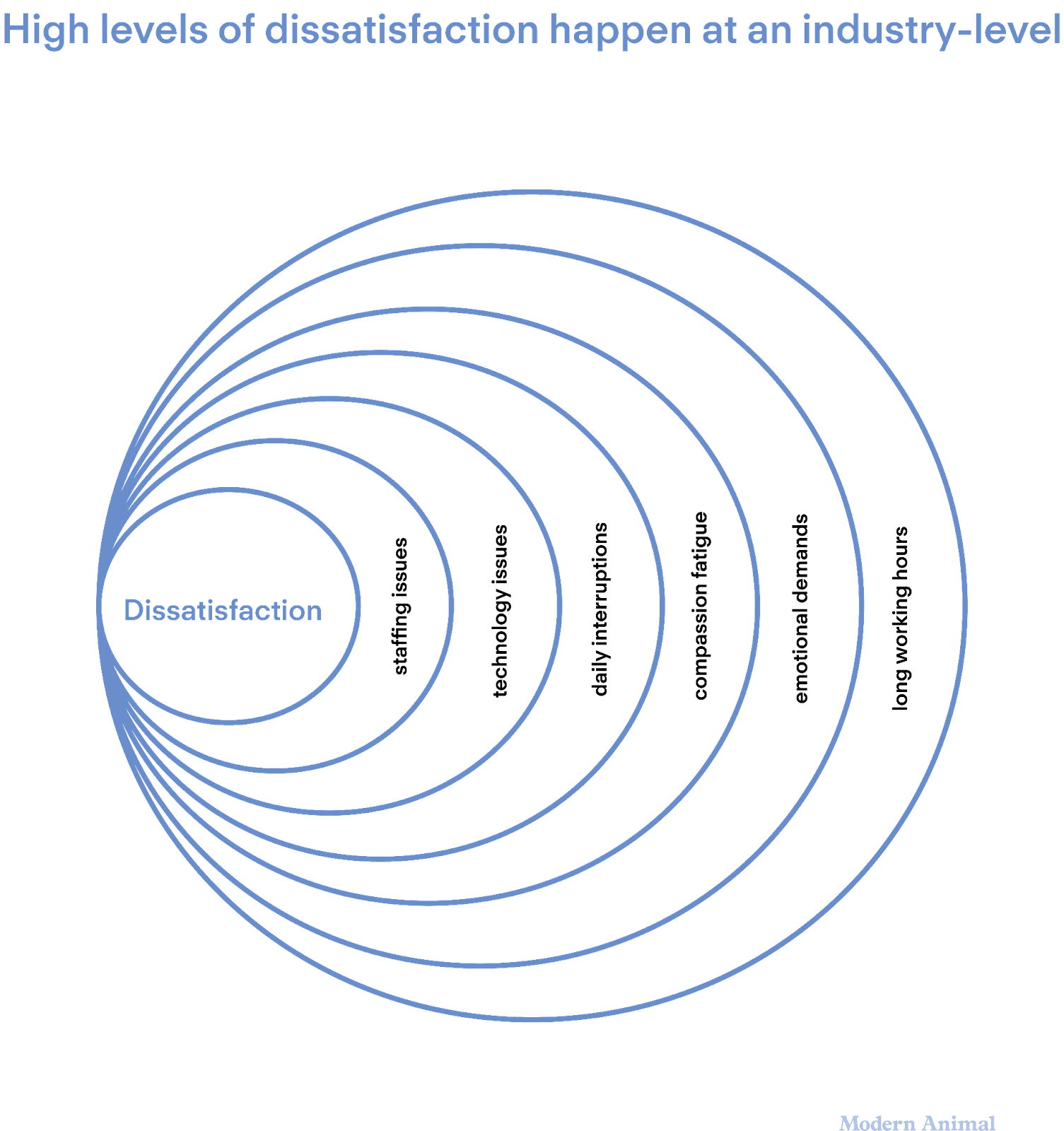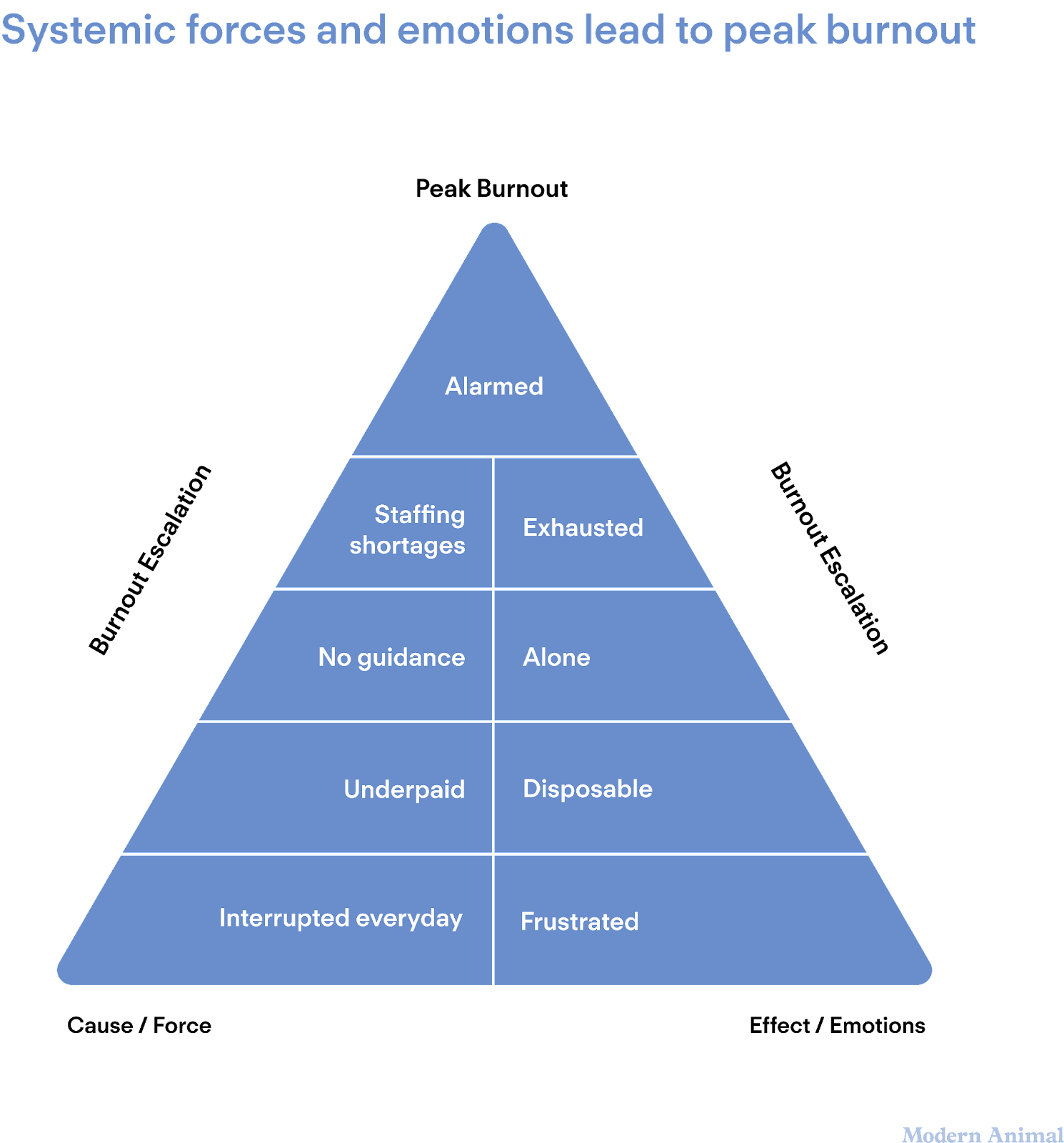More individuals and organizations are realizing how crucial practitioner well-being is in veterinary medicine. In the last year, there’s been a +209% increase in social content talking about burnout in veterinary medicine.
And, that’s likely not surprising to you. It feels like everytime you scroll there’s someone talking about it — whether it’s Galaxy Vet’s Veterinary Burnout Report that made waves last year or organizations like Not One More Vet talking about the risk of burnout in veterinary professionals.
Even when you google “Veterinary Burnout,” there’s almost 9 million results — even though there’s only about 120,000 veterinarians in the U.S. today.
But we wanted to dig deeper, below the surface-level topic, and really understand what contributes to burnout and if it could actually be “fixed.”
Modern Animal went deep into social listening data and found three key insights we can take away:
47% of content talking about burnout proposes self-care as a way to balance a veterinary career with personal life.
Can self-care effectively prevent burnout?
The veterinary landscape is currently focused on burnout, which is an outcome.
What actually causes burnout?
Veterinary professionals need a framework to assess and become aware of the factors that impact their satisfaction in both their work and personal lives.
What factors should veterinary professionals keep in mind when making decisions?
Can self-care effectively prevent burnout?
Although burnout is typically an individual experience, solutions often miss addressing other parts of the system. There is a growing body of evidence, both in the broader health context and within veterinary medicine, that points to systemic factors contributing to burnout.
The idea that self-care is the solution to burnout would be laughable, were the topic and its implications not so serious.
The "solution" to burnout is to eradicate its triggers by reframing the entire job in ways not previously imagined in veterinary medicine - by redesigning the way we care for patients, train our teams, build our workflows, and manage the expectations of our clients.
While making self-care a top priority in preventing burnout is crucial for veterinary professionals, it's equally vital to understand the broader forces that may either support or hinder self-care practices. The truth is, no level of self-care can fully compensate for factors beyond an individual's control.
One of the reasons veterinarians are flocking to relief practice is because it gives them the kind of control over their schedule that they haven't been able to achieve with full or part time employment.
They can titrate the workload to meet their needs whether these relate to family responsibilities, personal or professional growth, financial goals, or leisure activities.
What are the other systemic factors to burnout?
Beyond what veterinary professionals can individually control, three other forces influence burnout and shape their outlook on the profession.

1. Your Relationships
This includes the quality of interactions with supervisors, colleagues, and clients.
55% of veterinary professionals feel they lack support and respect from colleagues, supervisors, and clients.
2. Your Organization
The systems in place that influence workload, training, leadership, compensation, and culture.
64% of negative sentiment in veterinary medicine falls into this category.
The stakes are such that companies can no longer purchase practices and expect that the previously established culture and processes will carry the day.
At Modern Animal we believe that truly impactful change starts at the overall organizational level and is influenced by diverse industry perspectives; we cannot continue to do things the way we've always done them and expect different results.
3. Your Industry
Industry-wide challenges, staffing shortages, the cost to attend vet school, etc.
This is the least controllable out of all the systemic factors and according to the 2023 AVMA Report on the Economic State of the Veterinary Profession, has the highest levels of dissatisfaction versus the day-to-day job, compensation, and lifestyle.

Why is this important?
The real challenges that veterinary professionals encounter go beyond individual stress - it’s deeply connected to workplace relationships, organizations, and the industry as a whole. While self-care is valuable for prevention, it alone cannot fully address the burnout veterinary professionals experience.
If we want to ensure care providers at all levels have the support they need to set boundaries, have sustainable careers, and enjoy fulfilling lives beyond the exam room, then we need to understand that well-being is a shared responsibility between individuals and organizations.
In any workplace, culture exists whether or not it is intentionally created and is made up of individual behaviors and how people react to their environment.
Leadership can create systems to help team members feel safe, supported, and like partners in serving a larger goal.
Therefore fostering a healthy, positive culture is a shared responsibility between individuals and organizations.
The magnitude of change needed is such that it must be owned at the organizational level.
At Modern Animal, this means building a sustainable schedule that doesn't collapse with client demands, limiting weekend shifts, leveraging a virtual care organization to serve as the primary communication conduit between the practice and the client, and training teams to work efficiently and effectively.
How can we start making changes in our organizations?
Focusing on your people, purpose, and culture are excellent places to start.
One resource, “Just Culture” is a concept that originates from the aerospace industry but has been adopted and adapted in various industries, including healthcare, and can also apply to veterinary medicine. At its core, Just Culture focuses on creating a work environment that encourages open communication, learning from mistakes, and balancing individual and systemic accountability.
Modern Animal has embraced these principles, and here's how they can be relevant to veterinary medicine:
Balancing accountability:
Just Culture seeks to strike a balance between individual and systemic accountability.
In veterinary medicine, this means recognizing that while individual practitioners have a role in patient care and outcomes, systemic factors, such as workplace conditions and organizational policies, can significantly influence those outcomes.
Learning from mistakes:
A Just Culture encourages the reporting of errors, near-misses, and adverse events without fear of punitive measures.
In veterinary medicine, this means that if a mistake occurs, it should be viewed as an opportunity to learn and improve processes rather than assigning blame.
Transparency:
In this context, creating an environment where veterinary professionals can openly discuss challenges, share insights, and report concerns without fear of retaliation is crucial.
This level of openness can help identify systemic issues contributing to burnout.
Systemic improvements:
Just Culture acknowledges that systemic issues can contribute to errors and burnout.
In veterinary medicine, this means addressing issues like excessive workloads, inadequate staffing, and insufficient resources as part of a broader effort to improve patient care and practitioner well-being.
Leadership’s role:
Leaders are essential in fostering a Just Culture.
They should lead by creating an environment where individuals feel safe reporting problems, pushing for systemic improvements, and constantly aiming for betterment.
What actually causes burnout?
The American Veterinary Medical Association (AVMA) has identified four key forces that influence satisfaction levels of veterinary professionals:
1. Job (Micro)
Their day-to-day experience (i.e. hours, scheduling, team, client interactions, etc.).
2. Industry (Macro)
Support in navigating industry-wide challenges and outdated systems.
3. Compensation
Though part of the job, this is measured separately due to the rising debt-to-income ratios.
4. Lifestyle
The mental and physical capacity to enjoy their personal life (i.e. work-life balance).
The 2023 AVMA Report on the Economic State of the Veterinary Profession measured these forces individually and identified the highest levels of dissatisfaction at the industry-level. These challenges include:
- long working hours
- emotional demands
- compassion fatigue
- daily interruptions
- technology issues
- staffing shortages
This highlights the importance of organizations taking active steps to address these issues and improve the overall experience of veterinary professionals.

There is a frustrating cognitive dissonance when a practice purports to support individual well-being but the culture either overtly or subtly rewards excessive workloads and punishes acts of self-care.
I’ve seen this dynamic play out routinely in practices I’ve served in as both an associate and relief vet.
In veterinary medicine, we often hear about stress, exhaustion, burnout, and compassion fatigue as common emotional states. However, when you consider how your day-to-day, industry outlook, compensation, and lifestyle all interact, they can create more than 50 different emotional states.
For example, a veterinary professional may be content with their compensation and capable of coping with industry-wide challenges. However, they might experience exhaustion, frustration, and a sense of overwhelm if their job doesn't support time off.
The nuances and complexities of all of the different scenarios can lead to many different types of emotions before an individual reaches peak burnout.

Why is this important?
Emotions can serve as catalysts, driving veterinary professionals to take action, or they can become barriers, preventing them from making necessary changes.
Recognizing the specific elements lacking in each of these forces empowers veterinary professionals to identify their priorities, articulate what's missing, and ultimately, make choices that prioritize their well-being.
What factors should veterinary professionals keep in mind when making decisions?
Veterinary medicine, much like many other industries, doesn't have a straightforward way to evaluate what truly matters for job satisfaction and personal well-being. This can leave veterinary professionals unsure about how to assess and make decisions aligned with their needs.
Veterinarians own a portion of the responsibility for the lack of sustainability that exists in our jobs.
As a newly minted veterinarian I reported labs on my days off, gave clients my phone number and email address (creating the perception that I was always available, and in truth, I was), and came in on my days off to continue hospitalized patient care because my colleagues did.
By doing so, I perpetuated the very practices that create burnout without question. I alone was not strong enough to change this; I needed the support of a committed organization, which I did not have at that time.
Drawing from the research papers linked at the end of this section, a recurring theme emerges in personal and professional development literature - there are three primary categories for evaluation:
- Personal Factors
- Work Responsibilities
- Leadership, both on the job and organization-wide
1. Personal Factors
Personal Capacity: Energy available for areas outside of work.
- Do you have the physical and mental energy to support areas of your life outside of work?
- Does work prevent you from giving attention to important areas in your life (i.e. your wellbeing, health, family, friends, etc.)?
Enrichment: Skills and abilities expanding over time.
- Do you feel the skills and experiences you’re accumulating today will result in more opportunities and higher earning potential?
- Are you comfortable with exchanging your time, attention, and energy for the skills and experience you’re currently getting?
- Is there support and reimbursement in pursuing credential and CE opportunities?
Rest: Ability to take time off and recharge.
- Are you able to take time off when you need it?
- When you do take time off are you rested, recharged, and feeling at your best?
- Is your day-to-day so intense that you constantly feel you need a break?
Reward: How you’re compensated and recognized.
- Are you struggling, getting by, or comfortable with the pay?
- Do you have an understanding of how pay is structured?
- Is there a clear growth path forward? What options do you have available?
- Are there systems in your clinic to recognize and call out when you’re doing a good job?
Meaning: Connection between your passion, work, and goals.
- Are your day-to-day experiences meaningful to you?
- Are you working on things that connect back to your passions and goals?
2. Work Responsibilities
Clarity: Clear expectations and performance metrics.
- Are there clear standard operating procedures and protocols for exams, surgery, emergency, client communications, etc.?
- Do you have an understanding of what others expect from you?
- Is there a clear link between what you do and the clinic’s objectives?
- Do you have an understanding of how you’re performing and why?
Capacity: Necessary staff and resources to thrive in role.
- Are you given the necessary resources (i.e. staff, training, equipment, treatments offered, etc.) to provide high-quality care?
- Are you confident in your ability to deal with problems that come up? If not, do you have someone in the clinic you can go to?
- Is the physical workspace clean, organized, and has everything you need?
Relationships: Trust, authenticity, and positive relationships and interactions.
- Do you and your co-workers have mutual respect for one another?
- Do you trust your co-workers?
- Do you and your co-workers value each other’s input?
- Would your co-workers step in and have your back if you needed a moment on the job?
Autonomy: Trusted to make decisions based on expertise.
- Are you able to make decisions that allow you to provide high-quality care?
- Are you micromanaged on the job?
- Do you feel you have the flexibility to take actions you see fit based on the situation?
Utilization: How skills are utilized on the job.
- Is your job making good use of your skills and abilities?
- Are you being challenged in positive ways?
3. Leadership
Values: Alignment with attitudes and values.
- Are you able to articulate the attitudes and values of the organization?
- Does the organization have goals that extend beyond profits and production?
- Does the organization share the same values and attitudes you have?
Psychological Safety: Being your true self without fearing negative consequences.
- Do you feel comfortable sharing your ideas and opinions without fear of negative consequences?
- Are you encouraged to ask questions and seek clarification without feeling judged or criticized?
- Do you believe that mistakes or failures will be treated as learning opportunities rather than grounds for blame?
- Is there an open and non-judgmental atmosphere for discussing mental health and well-being concerns?
- Do you have the confidence that conflicts or disagreements will be addressed constructively and respectfully?
Integrity: Words and actions align.
- Does the organization follow through on what they say they’re going to do?
- Are the leaders in the organization reliable?
- Do you have transparency on why certain actions are taken?
- Are you comfortable and aligned with how change gets rolled out?
- Do you feel there’s equal treatment and standards for all?
Feedback: Openness to give, receive, and act on feedback via two-way communication.
- Do we make time to debrief in the moment and after the fact when feedback is necessary?
- Is the feedback you receive constructive and communicated respectfully?
- When you deliver feedback or communicate barriers that prevent you from reaching goals, do you see effort made in addressing your feedback?
Communication: Frequent, timely, and clear discussions.
- When you need to speak to someone, are they approachable and accessible?
- Are you in the know on all relevant updates and changes that impact your day-to-day?
Sources:
Development of the Job Diagnostic Survey - Hackman and Oldham, 1975
Key Takeaways:
- Well-being is a shared responsibility between individuals and organizations.
- Knowing what affects your emotions helps highlight what matters for your well-being.
- Assessing job satisfaction and well-being involves a deep dive into three categories: personal factors, work responsibilities, and leadership.



.png)


